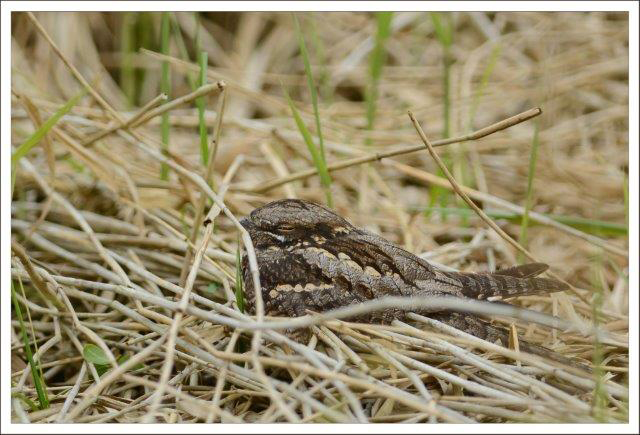Migrating nightjar dropped in for the day

The heavy winds in the Arun Valley brought an unusual visitor to the reserve last Wednesday. A nightjar was spotted by visitors and staff resting on the reeds near the entrance to the reedbed boardwalk at 1:30 pm. David Barrett captured a photo of the bird. The nightjar was likely migrating back from Africa and only dropped in for the day. Its dark grey feathers are patterned to look like bark so the bird was easy to spot against the light coloured reed. Nightjars are nocturnal and disappear into bracken or trees during the day by perching along a branch, instead of across it. Their feathers also camouflage them when they nest directly on the ground. They will lay two spotted eggs which are difficult to see.
The bird’s beak appears small but its mouth is very large, allowing the nightjar to troll for moths and insects while flying at night. Nightjar’s have whiskers on both side of their beak which protect the bird’s eyes when its mouth is open in flight.
The high winds brought a large tree down onto our electric perimeter fence last week. We examine our site regularly for standing deadwood that could fall down but this tree was healthy and very heavy. Perhaps its root base had been weakened by extremely wet weather over the winter. Ground Warden Suzi made short work of it with her chainsaw while Terry and the team affected immediate repairs.
The pair of common terns has been investigating the nesting raft near the Sand Martin hide but a black-headed gull has set up a pile of twigs in one corner. It seems to be a stand-off - sometimes the terns are on the raft with the gull or both terns will perch on the posts in the water near the raft and glare at the gull.
A pair of swallows are checking out the reedbed hide again this year. The pair that nested inside the hide last year raised two broods of chicks.
Wildlife sightings around the reserve: Blue tit, Great tit, Nuthatch, Blackbirds, Robins, Chaffinch, Goldfinch, Tree creepers, Wrens, Water voles, Moorhens and chicks, Coots and chicks, Reed buntings, Mallards and ducklings, Peregrines, Red kites.
At the Lapwing hide: 4 Grey lag geese with 15 goslings, 7 Lapwing and chicks, 10 Gadwall, 4 Shelduck, 3 Canada geese and goslings.
Between the Sand Martin and Ramsar hides: 28 Tufted duck, 2 Pochards, Swallows, Swifts, House Martins, 3 adult Lapwings and chicks, 2 Common terns.
